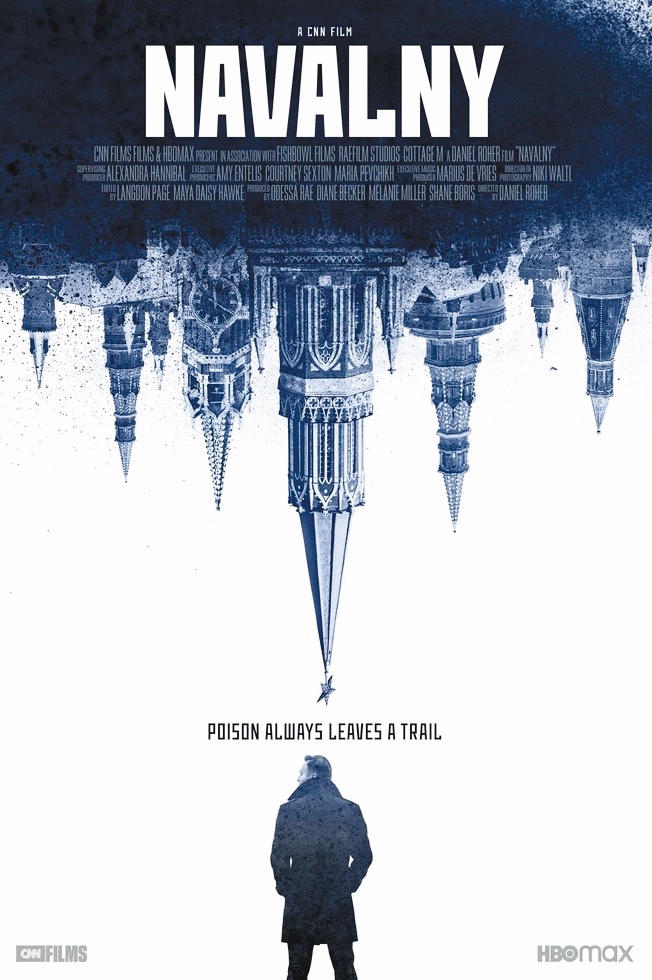Working with CNN Films and on HBO Max, Navalny follows Russia’s most notorious political dissident.
Filmmaker Daniel Roher and crew follow Alexei and his family after he is poisoned and almost lost his life. As it begins, we are set with a static medium shot of Navalny talking to Daniel and essentially to us. Errol Morris this is not however. A sense of fawning reverence falls over the project as it chugs along. Only one question of dubious intent is leveled against Alexei about being at a rally where neo-Nazis were present. Navalny weakly waves this off, claiming that he would have to deal with all sides of Russian people if he would lead. If only Roher had pushed down this road, but we can see why this would derail his message.

Navalny is the kind of saintly portrait you would expect. Roher intersperses scenes of Alexei with his family hiding in Germany, where he plays with goats and spends his downtime on his phone playing Call of Duty. When we see his investigators seek out who poisoned him, Laura Poitras’ Citizenfour comes to mind. And much like that Oscar-winning documentary, our subject is made to be at face value as righteous. Take that, for what it is worth. The pendulum swings the other way on Netflix’s The Girl in the Picture. We are never made to accept or sympathize but kept at a middle distance, a feature of the true crime genre. Director Skye Borgman drops us in the beginning when victim Tonya Tadlock is killed in a hit-and-run, leaving behind her son Michael. He was later abducted by Clarence, her supposed husband, from a foster family. Some trapdoors open up and the audience is dropped further with each new reveal and mystery. Tonya becomes Sharon and Clarence becomes Franklin as we transported back in time and place. 1990s Oklahoma is traded for 1980s Georgia and later Florida.
It is this segment that brings the most criticism. When we get to Tampa, more lurid elements are introduced with footage of female strippers to talk about Sharon’s time working one such place. Not completely counter-intuitive, but Borgman could have changed the mood to match Sharon’s darker existence. That does come in but a little too late, possibly not to alienate one interviewee who worked with her. Balance is a tricky endeavor. Safely Borgman doesn’t langur in hedonism for too long. What could have felt like a 2020 or Dateline segment on steroids becomes an emotional plea to find out the truth about who this woman was and the monster who took her life in many ways.
Destruction figures prominently in another feature by National Geographic, Fire of Love. Here filmmaker Sara Dosa constructs the lives of scientists Katia and Maurice Krafft. Vulcanology, a dangerous field of study, isn’t the first choice of a married couple one would think. But as Dosa begins to tell their story, we get swept up in their admiration. Both of them started camping on and observing active lava flows, even going so far as to cook eggs on still-cooling igneous.
Humor congeals next to fear, building up to their tragic death in 1991. Outcomes aside, the audience still wants to take the journey. Respect is given to light use of narration by Miranda July, adding only wonder and awe to their work. The Kraffts speak for themselves through archival footage; it’s ultimately their film. Use of cut-out animation to tell of their hometowns makes for magical flourish to this mythic couple.
My plan was to review this at an earlier time, due to fickle nature of theaters to keep docs for prolonged time. Fire of Love was in theaters for a while and, if you can find, please seek it out. If not, look for steaming whenever it comes about. It is truly inspired and beautiful viewing.



